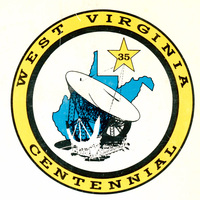 | Back to e-WV
| Back to e-WV
 The West Virginia Encyclopedia
The West Virginia Encyclopedia
 | Back to e-WV
| Back to e-WV
 The West Virginia Encyclopedia
The West Virginia Encyclopedia

The hills and valleys of the Mountain State came alive in 1963 as West Virginia celebrated 100 years of statehood. Musical events, drama, traveling exhibits, and festivities in each of the 55 counties highlighted the celebration. It began on West Virginia Day, June 20, 1962, with the appearance of former President Harry S. Truman at the state capitol in Charleston. One year later, on the state’s 100th birthday, President John F. Kennedy delivered the featured address at the state capitol. It was a rainy day, and the president took note. ‘‘The sun does not always shine in West Virginia, but the people do,’’ Kennedy said.
A nine-car Centennial exhibits train crisscrossed the state, making 58 stops in 95 days. Opening in Washington on May 31 and ending in South Charleston on September 2, the traveling exhibits focused on a message of pride in the past and confidence in the future. Attracting 319,000 visitors, the train was easily the most popular event during the anniversary year.
A Centennial showboat, the Rhododendron, carried the celebration to West Virginia waterways. The melodrama East Lynne, written in 1863, was presented on stage, along with other popular variety shows and local acts at the boat’s 21 stops in West Virginia and Pennsylvania. The Rhododendron had a 264-seat theater and a river museum.
Many events marked the celebration, including a special ceremonial session of the West Virginia legislature held on April 20, 1963, in Wheeling, the state’s first capital. It was on April 20, 1863, that President Lincoln issued a proclamation that in 60 days West Virginia would become a state. The legislature met in Wheeling’s old U.S. Custom House, later known as West Virginia Independence Hall, the birthplace of West Virginia.
The Forum of the Future, conducted in Charleston on April 25, 1963, established an editorial tone for the Centennial. The forum, highlighted by a panel including Vice President Lyndon B. Johnson, focused on a state aware of its problems with a determination to work toward solutions.
A Centennial sports banquet, attended by 1,500 at the Charleston Civic Center on April 6, 1963, recognized the contribution of sports to West Virginia’s heritage. Numerous sporting events, from fishing to football, were declared a part of the Centennial Games. In 1891, the West Virginia University Mountaineers had traveled up the Monongahela River by steamboat to play the first football game with the University of Pittsburgh. The Rhododendron carried the Pitt Panthers into Morgantown in October 1963 to play the Mountaineers at old Mountaineer Stadium before 32,000 and a national TV audience.
One of the most celebrated programs of the Centennial—the National Youth Science Camp —has continued every year since its beginning in 1963. Initiated to attract national recognition of scientific achievements and opportunities in West Virginia, the camp honored 100 scientifically talented senior high school students— two from each state—who spent two weeks at the camp in Pocahontas County. The huge Mountain State Art & Craft Fair held each July at Cedar Lakes in Jackson County is another Centennial event that has continued to the present.
Planning for the big celebration got under way early, when the legislature created a 15-member West Virginia Centennial Commission. The commission was reaffirmed in legislation of 1959, which also provided funding. Additional appropriations were voted in 1961 and 1963. Executive Director Carl R. Sullivan joined the staff in late 1961. When the Centennial year closed on December 31, 1963, virtually all elements of the program had been completed successfully, and a modest surplus remained of the $1.1 million budget.
Written by Lloyd P. Calvert